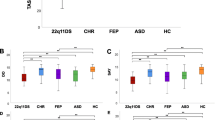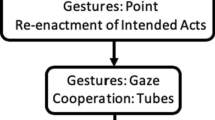Abstract
An explanation for the social dysfunction observed in Williams syndrome may be deficits in social cognition. This study explored aspects of social cognition in children with Williams syndrome with different genotypes. The 12 participants included one with a 1.1 Mb deletion that retained the GTF2IRD1, GTF2I, and GTF2IRD2 genes, seven with a 1.5 Mb deletion that preserved the GTF2IRD2 gene, and four with a 1.8 Mb deletion with loss of all three genes. The participant retaining all three genes was found to have better performance on social judgment and first-order theory of mind tasks than the group with loss of all three genes. These results may reflect the influence of the GTF2I gene family on social cognition in Williams syndrome.




Similar content being viewed by others
References
Adolphs, R. (2001). The neurobiology of social cognition. Current Opinion in Neurobiology, 11(2), 231–239. https://doi.org/10.1016/s0959-4388(00)00202-6.
Adolphs, R. (2009). The social brain: neural basis of social knowledge. Annual Review of Psychology, 60, 693–716. https://doi.org/10.1146/annurev.psych.60.110707.163514.
Amadó, A., Benejam, B., Mezuca, J., Serrat, E., & Vallès-Majoral, E. (2012). Socio-cognitive abilities in children with Down’s syndrome: results of a preliminary study. Medical Review on Down’s Syndrome., 16(3), 34–39.
Andrés-Roqueta, C. (2009). Pragmática y Cognición social en niños y niñas con Trastorno específico del lenguaje (TEL). (Doctorado), Universitat Jaume I de Castelló, Castellón.
Antonell, A., Del Campo, M., Magano, L., Kaufmann, L., Martínez de la Iglesia, J., Gallastegui, F., et al. (2010). Partial 7q11.23 deletions further implicate GTF2I and GTF2IRD1 as the main genes responsible for the Williams-Beuren syndrome neurocognitive profile. Journal of Medical Genetics, 47, 312–320. https://doi.org/10.1136/jmg.2009.071712.
Atlas, A. H. B. (2010). Allen Institute for Brain Science. Retrieved from human.brain-map.org
Bellugi, U., Lichtenberger, L., Mills, D., Galaburda, A., & Korenberg, J. (1999). Briding cognition, the brain and molecular genetics: evidence from Williams syndrome. Trends in Neurosciences, 22, 197–207.
Bellugi, U., et al. (2007). Affect, social behavior, and the brain in Williams syndrome. Current directions in psychological science, 16(2), 99–104.
Borg, I., Delhanty, J. D., & Baraitser, M. (1995). Detection of hemizygosity at the elastin locus by FISH analysis as a diagnostic test in both classical and atypical cases of Williams syndrome. Journal of medical genetics, 32(9), 692–696.
Butman, J. (2001). La cognición social y la corteza cerebral. Revista Neurológica Argentina, 26, 117–122.
Campos, R., & Martínez-Castilla Sotillo, M. (2014). Cognición social en el síndrome de Williams. Revista de Psicología Social: International Journal of Social Psychology, 28(3), 249–360.
Chailangkarn, T., Trujillo, C. A., Freitas, B. C., Hrvoj-Mihic, B., Herai, R. H., Diana, X. Y., et al. (2016). A human neurodevelopmental model for Williams syndrome. Nature, 536(7616), 338–343.
Chailangkarn, T., Noree, C., & Muotri, A. R. (2018). The contribution of GTF2I haploinsufficiency to Williams syndrome. Molecular and cellular probes, 40, 45–51.
Crawford, J. R., & Howell, D. C. (1998). Comparing an Individual´s Test Score Against Norms Derived from Small Samples. The Clinical Neuropsychologist, 12(4), 482–486. https://doi.org/10.1076/clin.12.4.482.7241.
Crespi, B. J., & Hurd, P. L. (2014). Cognitive-behavioral phenotypes of Williams syndrome are associated with genetic variation in the GTF2I gene, in a healthy popoulation. BMC Neuroscience. https://doi.org/10.1186/s12868-014-0127-1.
Dai, L., Bellugi, U., Chen, X., Pulst-Korenberg, A. M., Järvinen-Pasley, A., Tirosh-Wagner, T., et al. (2008). Is it Williams Syndrome? GTF2IRD1 Implicated in Visual-Spatial Construction and GTF2I in sociability revealed by high resolution arrays. American Journal of Medical Genetics, 149A, 302–314.
Dunn, O. J. (1964). Multiple comparisons using rank sums. Technometrics, 6, 241–252.
Ekman, P., Friesen, W., & Press, C. (1976). Pictures of facial affect (Vol. 21). Palo Alto CA: Consulting Psychologists Press.
Ferrero, G., Howald, C., Micale, L., Biamino, E., Augello, B., Fusco, C., et al. (2010). An atypical 7q11.23 deletion normal IQ Williams-Beuren syndrome patient. European Jorunal of Human Genetics, 18, 33–38.
Fisher, M. H., & Morin, L. (2017). Addressing social skills deficits in adults with Williams syndrome. Research in developmental disabilities, 71, 77–87.
Gagliardi, C., Frigerio, E., Burt, M., Cazzaniga, I., Perrett, D., & Borgatti, R. (2003). Facial expression recognition in Williams syndrome. Neuropsychologia, 41(6), 733–738. https://doi.org/10.1016/S0028-3932(02)00178-1.
Happé, F. (1994). An advanced test of theory of mind: understanding of story characters´ thoughts and feelings by able autistic, mentally handicapped, and normal children and adults. Journal of Autism and Developmental Disorders, 24(2), 129–154.
Hernández Galván, A., & Yáñez-Téllez, M. G. (2003). Evaluación de la cognición social en adultos mayores: presentación de la batería COGSOC-AM (pp. 269–278). XXII: Revista Argentina de Clínica Psicológica.
Hirota, H., Matsuoka, R., Chen, X.-N., Salandanan, L., Lincoln, A., Rose, F., et al. (2003). Williams syndrome deficits in visual spatial processing linked to GTF2IRD1 and GTF2I on chromosome 7q1123. Genet Med, 5(4), 311–321. https://doi.org/10.1097/01.GIM.0000076975.10224.67.
Hoeft, F., Dai, L., Haas, B. W., Sheau, K., Mimura, M., Mills, D., et al. (2014). Mapping genetically controlled neural circuits of social behavior and visuo-motor integration by a preliminary examination of atypical deletions with Williams syndrome. PLoS ONE, 9(8), e104088.
Järvinen, A., Crivelli, D., Arnold, A., Woo-Von Hoogenstyn, N., & Bellugi, U. (2015). Relations between social-perceptual ability in multi and unisensory context, autonomic reactivity, and social functioning in individuals with Williams syndrome. Neuropsychologia, 73, 127–140.
Järvinen, A., Korenberg, J., & Bellugi, U. (2013). The social phenotype of Williams syndrome. Current Opinion in Neurobiology, 23, 414–422. https://doi.org/10.1016/j.conb.2012.12.006.
Järvinen-Pasley, A., Bellugi, U., Reilly, J., Mills, D., Galaburda, A., Reiss, A., et al. (2008). Defining the social phenotype in Williams syndrome: A model for linking gene, the brain, and behavior. Development and Psychopathology, 20, 1–35. https://doi.org/10.1017/S0954579408000011.
Karmiloff-Smith, A., Broadbent, H., Farran, E., Longhi, E., D´Souza, D., Metcalfe, K., et al. (2012). Social cognition in Williams Syndrome: genotype/phenotype insights from partial deletion patients. Frontiers in Psychology. https://doi.org/10.3389/fpsyg.2012.00168.
Karmiloff-Smith, A., Klima, E., Bellugi, U., Grant, J., & Baron-Cohen, S. (1995). Is There a Social Module? Language, Face Processing, and Theory of Mind in Individuals with Williams Syndrome. Journal of Cognitive Neuroscience, 7(2), 196–208. https://doi.org/10.1162/jocn.1995.7.2.196.
Kopp, N., McCullough, K., Maloney, S. E., & Dougherty, J. D. (2019). Gtf2i and Gtf2ird1 mutation do not account for the full phenotypic effect of the Williams syndrome critical region in mouse models. Human molecular genetics, 28(20), 3443–3465.
Kovas, Y., & Plomin, R. (2006). Generalist genes: implications for the cognitive sciences. Trends in cognitive sciences, 10(5), 198–203.
Lalli, M. A., Jang, J., Park, J. H. C., Wang, Y., Guzman, E., Zhou, H., et al. (2016). Haploinsufficiency of BAZ1B contributes to Williams syndrome through transcriptional dysregulation of neurodevelopmental pathways. Human molecular genetics, 25(7), 1294–1306.
Laerd Statistics (2015). Kruskal-Wallis H test using SPSS Statistics. Statistical tutorials and software guides. Retrieved from https://statistics.laerd.com/
Levy, Y., & Eilam, A. (2013). Pathways to language: a naturalistic study of children with Williams syndrome and children with Down syndrome. Journal of Child Language, 40(1), 106–138. https://doi.org/10.1017/S0305000912000475.
Makeyev, A., Erdenechimeg, L., Mungunsukh, O., Roth, J., Enkhmandakh, B., Ruddle, F., et al. (2004). GTF2IRD2 is located in the Williams-Beuren syndrome critical region 7q1123 and encodes a protein with two TFII-I-like kelix-loop-helix repeats. PNAS, 101(30), 11052–11057.
Malenfant, P., Liu, X., Hudson, M., Qiao, Y., Hrynchak, M., Riendeau, N., et al. (2012). Association of GTF2i in the Williams-Beuren syndrome critical region with Autism Spectrum Disorders. Journal of Autism and Developmental Disorders, 42, 1459–1469. https://doi.org/10.1007/s10803-011-1389-4.
Martens, M., Wilson, S., & Reutens, D. (2008). Research Review: Williams syndrome, a critical review of the cognitive, behavioral, and neuroanatomical phenotype. The Journal of Child Psychology and Psychiatry, 49(6), 576–608.
Martínez-Castilla, P., Burt, M., Borgatti, R., & Gagliardi, C. (2015). Facial emotion recognition in William Syndrome and Down Syndrome: A matching and developmental study. Child Neuropsychology., 21(5), 668–692.
Mervis, C., & Morris, C. A. (2007). Williams Syndrome. In M. Mazzocco & J. Ross (Eds.), Neurogenetic Developmental Disorders. London: The MIT Press.
Meyer-Linderberg, A., Mervis, C., & Berman, K. F. (2006). Neural mechanisms in Williams syndrome: a unique window to genetic influences on cognition and behaviour. Nature Reviews, 7, 380–393. https://doi.org/10.1038/nrn1906.
Miezah, D., Porter, M., Batchelor, J., Boulton, K., & Veloso, G. C. (2020). Cognitive abilities in Williams syndrome. Research in Developmental Disabilities, 104, 103701.
Pavlova, M., Heliz, J., Sokolov, A., & Barisnikov, K. (2016). Social cognition in Williams Syndrome: Face tuning. Frontiers in Psycholog., 7, 1131. https://doi.org/10.3389/fpsyg.2016.01131.
Palmer, S., Taylor, K. M., Santucci, N., Widago, J., Chan, Y.-K. A., Yeo, J.-L., et al. (2012). GTF2IRD2 from the Williams-Beuren critical region encodes a mobile-element-derived fusion protein that antagonizes the action of its related family members. Journal of Cell Science, 125, 5040–5050. https://doi.org/10.1242/jcs.102798.
Plesa Skwerer, D., Verbalis, A., Schofield, C., Faja, S., & Tager-Flusberg, H. (2006). Social-perceptual abilities in adolescents and adults with Williams syndrome. Cognitive Neuropsychology, 23(2), 338–349. https://doi.org/10.1080/02643290542000076.
Pober, B. (2010). Williams-Beuren Syndrome. The New England Journal of Medicine, 362, 239–352.
Porter, M. A., & Coltheart, M. (2005). Cognitive heterogeneity in Williams syndrome. Developmental neuropsychology, 27(2), 275–306.
Porter, M., Coltheart, M., & Langdon, R. (2008). Theory of Mind in Williams Syndrome Assessed Using a Nonverbal Task. Journal of Autism and Developmental Disorders, 38, 806–814. https://doi.org/10.1007/s10803-007-0447-4.
Porter, M., Dobson-Stone, C., Kwok, J., Schofield, P., Beckett, W., & Tassabehji, M. (2012). A role of transcription factor GTF2IRD2 in Executive Function in Williams-Beuren Syndrome. PLoS ONE, 7(10), e47457. https://doi.org/10.1371/journal.pone.0047457.
Quinn, K., Macrae, C. Neil, & Bodenhausen, G. (2006). Social Cognition. In Annual Review of Psychology (Vol. 51).
Ramírez-Velasco, A., & Domínguez-Quezada, M. (2017). Deleciones atípicas en el síndrome de Williams-Beuren. Revista Mexicana del Instituto Mexicano del Seguro Social, 55(5), 5615–5620.
Serrano-Juárez, C. A., Venegas-Vega, C. A., Yáñez-Téllez, M. G., Rodríguez-Camacho, M., Silva-Pereyra, J., Salgado-Ceballos, H., et al. (2018). Cognitive, behavioural, and adaptive profiles in Williams syndrome with and without loss of GTF2IRD2. Journal of the International Neuropsychological Society, 24, 896–904. https://doi.org/10.1017/S1355617718000711.
Tager-Flusberg, H., & Baron-Cohen, S. (1998). Reading the Windows to the Soul: Evidence of Domain-Specific Sparing in Williams Syndrome. Journal of Cognitive Neuroscience, 10(5), 631–639. https://doi.org/10.1162/089892998563031.
Tipney, H., Hinsley, T., Brass, A., Metcalfe, K., Donnai, D., & Tassabehji, M. (2004). Isolation and characterisation of GTF2IRD2, a novel fusion gene and member of the TFII-I family of transcription factors, deleted in Williams-Beuren syndrome. European Jorunal of Human Genetics, 12, 551–560.
Tirapu-Ustárroz, J., Pérez-Sayes, G., Erekatxo-Bilbao, M., & Pelegrín-Valero, C. (2007). Qué es la teoría de la mente? Revista de Neurología, 44, 479–489.
Uhlén, M., Fagerberg, L., Hallström, B., Lindskog, C., Oksvold, P., Mardinoglu, A., et al. (2015). Tissue-based map of the human proteome. Science. https://doi.org/10.1126/science.1260419.
van der Fluit, F., Gaffrey, M., & Kelin-Tasman, B. (2012). Social cognition in Williams syndrome: relations between performance on the social attribution task and cognitive and behavioral characteristics. Frontiers in Psychology., 3, 197. https://doi.org/10.3389/fpsyg.2012.00197.
Venegas Vega, C. A. (2012). Pruebas citogenéticas basadas en microarreglos. In V. Del Castillo Ruiz, R. D. Uranga Hernández, & G. Zafra de la Rosa (Eds.), Genética Clínica. México: Manual Moderno.
Wechsler, D. (2007). Escala Wechsler de Inteligencia para Niños y Adolescentes-IV. México: Manual Moderno.
Wechsler, D. (2014). Escala Wechsler de Inteligencia para Adultos-IV. México: Manual Moderno.
Zegarra-Valdivia, J., & Chino Vilca, B. (2017). Mentalización y teoría de la mente. Revista de Neuro-Psiquiatría, 80(3), 189–199.
Acknowledgments
Programa de Apoyo de Proyectos de Investigación e Innovación Tecnológica PAPIIT, DGAPA-UNAM IN308719 e IA301916 and CONACYT CVU 478060 (Carlos Alberto Serrano Juárez).
Author information
Authors and Affiliations
Contributions
CAS-J conceptualized the project, collected and analyzed the data, wrote and revised the manuscript, edited, and produced the final manuscript. BP-C conceptualized the project and analyzed the data. She wrote and revised the manuscript, edited, and produced the final manuscript. MR-C analyzed the data. He wrote and revised the manuscript, edited, and produced the final manuscript. CV-V Clinical review of patients with WS. He interpreted the chromosome microarray studies. MGY-T, JS-P, HS-C, NA-T, and MAD-M analyzed the data, contributed to the writing, and revised the manuscript.
Corresponding author
Additional information
Publisher's Note
Springer Nature remains neutral with regard to jurisdictional claims in published maps and institutional affiliations.
Electronic supplementary material
Below is the link to the electronic supplementary material.
Rights and permissions
About this article
Cite this article
Serrano-Juárez, C.A., Prieto-Corona, B., Rodríguez-Camacho, M. et al. An Exploration of Social Cognition in Children with Different Degrees of Genetic Deletion in Williams Syndrome. J Autism Dev Disord 51, 1695–1704 (2021). https://doi.org/10.1007/s10803-020-04656-4
Published:
Issue Date:
DOI: https://doi.org/10.1007/s10803-020-04656-4




